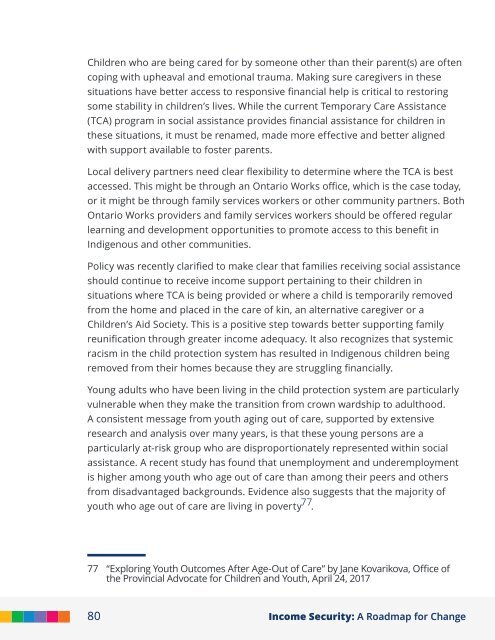Income Security: A Roadmap for Change
You also want an ePaper? Increase the reach of your titles
YUMPU automatically turns print PDFs into web optimized ePapers that Google loves.
Children who are being cared <strong>for</strong> by someone other than their parent(s) are often<br />
coping with upheaval and emotional trauma Making sure caregivers in these<br />
situations have better access to responsive financial help is critical to restoring<br />
some stability in children’s lives While the current Temporary Care Assistance<br />
(TCA) program in social assistance provides financial assistance <strong>for</strong> children in<br />
these situations, it must be renamed, made more effective and better aligned<br />
with support available to foster parents<br />
Local delivery partners need clear flexibility to determine where the TCA is best<br />
accessed. This might be through an Ontario Works offce, which is the case today,<br />
or it might be through family services workers or other community partners Both<br />
Ontario Works providers and family services workers should be offered regular<br />
learning and development opportunities to promote access to this benefit in<br />
Indigenous and other communities<br />
Policy was recently clarified to make clear that families receiving social assistance<br />
should continue to receive income support pertaining to their children in<br />
situations where TCA is being provided or where a child is temporarily removed<br />
from the home and placed in the care of kin, an alternative caregiver or a<br />
Children’s Aid Society This is a positive step towards better supporting family<br />
reunification through greater income adequacy. It also recognizes that systemic<br />
racism in the child protection system has resulted in Indigenous children being<br />
removed from their homes because they are struggling financially.<br />
Young adults who have been living in the child protection system are particularly<br />
vulnerable when they make the transition from crown wardship to adulthood<br />
A consistent message from youth aging out of care, supported by extensive<br />
research and analysis over many years, is that these young persons are a<br />
particularly at-risk group who are disproportionately represented within social<br />
assistance A recent study has found that unemployment and underemployment<br />
is higher among youth who age out of care than among their peers and others<br />
from disadvantaged backgrounds Evidence also suggests that the majority of<br />
youth who age out of care are living in poverty 77 <br />
77 “Exploring Youth Outcomes After Age-Out of Care” by Jane Kovarikova, Offce of<br />
the Provincial Advocate <strong>for</strong> Children and Youth, April 24, 2017<br />
80 <strong>Income</strong> <strong>Security</strong>: A <strong>Roadmap</strong> <strong>for</strong> <strong>Change</strong>
















